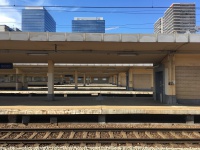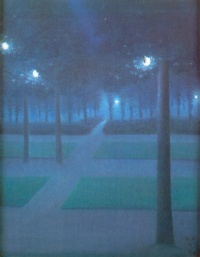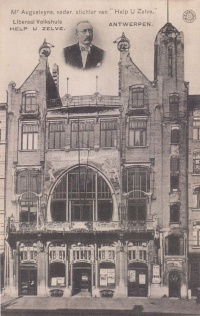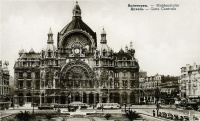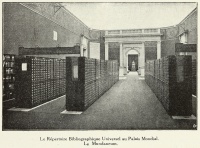Belgium
From The Art and Popular Culture Encyclopedia
|
"As Made in Belgium was a one-dimensional collection of simplified national pride, Visionary Belgium showed exactly the opposite: an ironic reflection on the soul-searching of the arts in their effort to say something essential on the country, its inhabitants and its history."--How Can One Not be Interested in Belgian History (2005) by Benno Barnard Canon: Paul Otlet Literary canon Dutch: Gust Gils, Delphine Lecompte, Roger van de Velde, Joost Vandecasteele, Paul van Ostaijen, Yves Petry French language: Georges Simenon, Jacques Sternberg Arts: Kamagurka "The country called Belgium at the present day, which was originally peopled with a race of Celtic origin, and was subsequently overrun by Teutonic invaders, was conquered by Caesar, and remained under Roman supremacy until the beginning of the 5th century, when the Salic Franks established themselves in the district between the Schelde, the Meuse, and the Lower Rhine. In the 9th century the country formed part of the Empire of Charlemagne. By the treaty of Verdun (843) the western provinces, Flanders and Artois, became part of France, while the eastern, including Brabant, fell to the share of Germany."--Belgium and Holland: Handbook for Travellers (1891) by Baedeker "On the way down to Antwerp the canals and windmills begin to disappear. The country is as flat as Holland, but has lost its characteristic charm. It has become less symmetrical; there is disorder in the sky-line, more trees, the architecture is different. Dutch precision has vanished. The railway carriages are not clean, punctuality is avoided, the people seem less prosperous, few speak English, and as you near Antwerp the villas and roads tell you that you are in the dominion of the King of Belgium. But Antwerp is so distinctly Flemish that you forget that bustling modern Brussels is only thirty-six minutes away by the express--a fast train for once in this land of snail expresses." --Promenades of an Impressionist (1910) by James Huneker |

|
Related e |
|
Featured: |
The Kingdom of Belgium is a country in northwest Europe bordered by France, the Netherlands, Germany and Luxembourg. Belgium has a population of over ten million people, in an area of around 30,000 square kilometres.
Straddling the cultural boundary between Germanic and Latin Europe, Belgium is linguistically divided. It has two main languages: ca. 60% of its population , mainly in the region Flanders, speak Dutch (while Belgians often refer to it as Flemish), while French is spoken by 40%.
Belgium is well-known for its fine art and architecture. The region corresponding to today's Belgium has seen the flourishing of major artistic movements that have had tremendous influence over European art.
Contents |
Culture
Despite its political and linguistic divisions, the region corresponding to today's Belgium has seen the flourishing of major artistic movements that have had tremendous influence on European art and culture. Nowadays, to a certain extent, cultural life is concentrated within each language Community, and a variety of barriers have made a shared cultural sphere less pronounced. and no single large cultural or scientific organisation in which both main communities are represented.
Fine arts
Contributions to painting and architecture have been especially rich. The Mosan art, the Early Netherlandish, the Flemish Renaissance and Baroque painting and major examples of Romanesque, Gothic, Renaissance and Baroque architecture are milestones in the history of art. While the 15th century's art in the Low Countries is dominated by the religious paintings of Jan van Eyck and Rogier van der Weyden, the 16th century is characterized by a broader panel of styles such as Peter Breughel's landscape paintings and Lambert Lombard's representation of the antique. Though the Baroque style of Peter Paul Rubens and Anthony van Dyck flourished in the early 17th century in the Southern Netherlands, it gradually declined thereafter.
During the 19th and 20th centuries many original romantic, expressionist and surrealist Belgian painters emerged, including James Ensor and other artists belonging to the Les XX group, Constant Permeke, Paul Delvaux and René Magritte. The avant-garde CoBrA movement appeared in the 1950s, while the sculptor Panamarenko remains a remarkable figure in contemporary art. The multidisciplinary artist Jan Fabre and the painter Luc Tuymans are other internationally renowned figures on the contemporary art scene.
The largest collection of Belgian "minor" surrealists can be seen at the Verbeke Foundation.
Belgian contributions to architecture also continued into the 19th and 20th centuries, including the work of Victor Horta and Henry van de Velde, who were major initiators of the Art Nouveau style.
The vocal music of the Franco-Flemish School developed in the southern part of the Low Countries and was an important contribution to Renaissance culture. In the 19th and 20th centuries, there was an emergence of major violinists, such as Henri Vieuxtemps, Eugène Ysaÿe and Arthur Grumiaux, while Adolphe Sax invented the saxophone in 1846. The composer César Franck was born in Liège in 1822. Contemporary music in Belgium is also of repute. Jazz musician Toots Thielemans and singer Jacques Brel have achieved global fame. In rock/pop music, Telex, Front 242, K's Choice, Hooverphonic, Zap Mama, Soulwax and dEUS are well known. In the heavy metal scene, bands like Machiavel, Channel Zero and Enthroned have a worldwide fan-base. Belgium has produced several well-known authors, including the poet Emile Verhaeren and novelists Hendrik Conscience, Georges Simenon, Suzanne Lilar, Hugo Claus, and Amélie Nothomb. The poet and playwright Maurice Maeterlinck won the Nobel Prize in literature in 1911. The Adventures of Tintin by Hergé is the best known of Franco-Belgian comics, but many other major authors, including Peyo (The Smurfs), André Franquin (Gaston Lagaffe), Edgar P. Jacobs and Willy Vandersteen brought the Belgian cartoon strip industry a worldwide fame.
Belgian cinema has brought a number of mainly Flemish novels to life on-screen. Notable Belgian films based on works by Flemish authors include: De Witte (author Ernest Claes) movie by Jan Vanderheyden and Edith Kiel in 1934, remake as De Witte van Sichem directed by Robbe De Hert in 1980; De man die zijn haar kort liet knippen (Johan Daisne) André Delvaux 1965; Mira ('De teleurgang van de Waterhoek' by Stijn Streuvels) Fons Rademakers 1971; Malpertuis (aka The Legend of Doom House) (Jean Ray [pen name of Flemish author who mainly wrote in French, or as John Flanders in Dutch]) Harry Kümel 1971; De loteling (Hendrik Conscience) Roland Verhavert 1974; Dood van een non (Maria Rosseels) Paul Collet and Pierre Drouot 1975; Pallieter (Felix Timmermans) Roland Verhavert 1976; De komst van Joachim Stiller (Hubert Lampo) Harry Kümel 1976; De Leeuw van Vlaanderen (Hendrik Conscience) Hugo Claus (a famous author himself) 1985; Daens ('Pieter Daens' by Louis Paul Boon) Stijn Coninx 1992 Other Belgian directors include André Delvaux, Stijn Coninx, Luc and Jean-Pierre Dardenne; well-known actors include Jean-Claude Van Damme, Jan Decleir and Marie Gillain; and successful films include Bullhead, Man Bites Dog and The Alzheimer Affair.
Folklore
Folklore plays a major role in Belgium's cultural life: the country has a comparatively high number of processions, cavalcades, parades, 'ommegangs' and 'ducasses', 'kermesse' and other local festivals, nearly always with an originally religious or mythological background. The Carnival of Binche with its famous Gilles and the 'Processional Giants and Dragons' of Ath, Brussels, Dendermonde, Mechelen and Mons are recognised by UNESCO as Masterpieces of the Oral and Intangible Heritage of Humanity.
Other examples are the Carnival of Aalst; the still very religious processions of the Holy Blood in Bruges, Virga Jesse Basilica in Hasselt and Basilica of Our Lady of Hanswijk in Mechelen; 15 August festival in Liège; and the Walloon festival in Namur. Originated in 1832 and revived in the 1960s, the Gentse Feesten have become a modern tradition. A major non-official holiday is the Saint Nicholas Day, a festivity for children and, in Liège, for students.
Cuisine
Many highly ranked Belgian restaurants can be found in the most influential restaurant guides, such as the Michelin Guide. Belgium is famous for beer, chocolate, waffles and french fries with mayonnaise. Contrary to their name, french fries are claimed to have originated in Belgium, although their exact place of origin is uncertain. The national dishes are "steak and fries with salad", and "mussels with fries".
Brands of Belgian chocolate and pralines, like Côte d'Or, Neuhaus, Leonidas and Godiva are famous, as well as independent producers such as Burie and Del Rey in Antwerp and Mary's in Brussels. The Trappist beer of the Abbey of Westvleteren has repeatedly been rated the world's best beer.
History
The name 'Belgium' is derived from Gallia Belgica, a Roman province in the northernmost part of Gaul that before Roman invasion in 100 BC, was inhabited by the Belgae, a mix of Celtic and Germanic peoples.
A gradual immigration by Germanic Frankish tribes during the 5th century brought the area under the rule of the Merovingian kings. A gradual shift of power during the 8th century led the kingdom of the Franks to evolve into the Carolingian Empire.
The Treaty of Verdun in 843 divided the region into Middle and West Francia and therefore into a set of more or less independent fiefdoms which, during the Middle Ages, were vassals either of the King of France or of the Holy Roman Emperor.
Many of these fiefdoms were united in the Burgundian Netherlands of the 14th and 15th centuries.
Emperor Charles V extended the personal union of the Seventeen Provinces in the 1540s, making it far more than a personal union by the Pragmatic Sanction of 1549 and increased his influence over the Prince-Bishopric of Liège.
The Eighty Years' War (1568–1648) divided the Low Countries into the northern United Provinces (Belgica Foederata in Latin, the "Federated Netherlands") and the Southern Netherlands (Belgica Regia, the "Royal Netherlands"). The latter were ruled successively by the Spanish and the Austrian Habsburgs and comprised most of modern Belgium. This was the theatre of most Franco-Spanish and Franco-Austrian wars during the 17th and 18th centuries.
Following the campaigns of 1794 in the French Revolutionary Wars, the Low Countries—including territories that were never nominally under Habsburg rule, such as the Prince-Bishopric of Liège—were annexed by the French First Republic, ending Austrian rule in the region. The reunification of the Low Countries as the United Kingdom of the Netherlands occurred at the dissolution of the First French Empire in 1815, after the defeat of Napoleon.
In 1830, the Belgian Revolution led to the separation of the Southern Provinces from the Netherlands and to the establishment of a Catholic and bourgeois, officially French-speaking and neutral, independent Belgium under a provisional government and a national congress.
Since the installation of Leopold I as king on 21 July, 1831 (which is now celebrated as Belgium's National Day), Belgium has been a constitutional monarchy and parliamentary democracy, with a laicist constitution based on the Napoleonic code. Although the franchise was initially restricted, universal suffrage for men was introduced after the general strike of 1893 (with plural voting until 1919) and for women in 1949.
The main political parties of the 19th century were the Catholic Party and the Liberal Party, with the Belgian Labour Party emerging towards the end of the 19th century. French was originally the single official language adopted by the nobility and the bourgeoisie. It progressively lost its overall importance as Dutch became recognised as well. This recognition became official in 1898 and in 1967 a Dutch version of the Constitution was legally accepted.
The Berlin Conference of 1885 ceded control of the Congo Free State to King Leopold II as his private possession. From around 1900 there was growing international concern for the extreme and savage treatment of the Congolese population under Leopold II, for whom the Congo was primarily a source of revenue from ivory and rubber production. In 1908 this outcry led the Belgian state to assume responsibility for the government of the colony, henceforth called the Belgian Congo.
Germany invaded Belgium in 1914 as part of the Schlieffen Plan to attack France and much of the Western Front fighting of World War I occurred in western parts of the country. The opening months of the war were known as the Rape of Belgium due to German excesses. Belgium took over the German colonies of Ruanda-Urundi (modern day Rwanda and Burundi) during the war, and they were mandated to Belgium in 1924 by the League of Nations. In the aftermath of the First World War, the Prussian districts of Eupen and Malmedy were annexed by Belgium in 1925, thereby causing the presence of a German-speaking minority.
The country was again invaded by Germany in 1940 and was occupied until its liberation by the Allies in 1944. After World War II, a general strike forced King Leopold III who many viewed as collaborating with Germany during the war, to abdicate in 1951. The Belgian Congo gained independence in 1960 during the Congo Crisis; Ruanda-Urundi followed with its independence two years later. Belgium joined NATO as a founding member and formed the Benelux group of nations with the Netherlands and Luxembourg.
Belgium became one of the six founding members of the European Coal and Steel Community in 1951 and of the European Atomic Energy Community and European Economic Community, established in 1957. The latter is now the European Union, for which Belgium hosts major administrations and institutions, including the European Commission, the Council of the European Union and the extraordinary and committee sessions of the European Parliament.
Architecture
The romanesque Collégiale Saint-Gertrude de Nivelles (1046) and Cathédrale Notre-Dame de Tournai, gothic 15th-century Cathedral of Our Lady in Antwerp and baroque Brussels Grand'Place. Mosan Renaissance style is typical of the architecture within the Prince-Bishopric of Liège. Famous Art Nouveau architects Victor Horta and Henry van de Velde have influenced the early 20th-century architecture in Belgium and abroad.
People
See also
- Belgian art
- Reading Between the Lines (2011) by Gijs Van Vaerenbergh
- Belgian cinema
- Belgian Institute of World Affairs
- Belgian boondoggles
- Belgian counterculture
- Belgian fashion
- Belgian graphic design
- Belgian literature
- Belgian music
- Belgitude
- List of monumental trees in Belgium
- List of botanical gardens in Belgium
- List of castles and châteaux in Belgium
- List of protected areas of Belgium
- Les Plus Beaux Villages de Wallonie
- Het mooiste dorp van Vlaanderen
- Visionary Belgium (2005) by Harald Szeemann
- List of World Heritage Sites in Belgium
- Museum of Industry (Ghent)
- Belgium in the long nineteenth century
- Royal Saint-Hubert Galleries
- Walzin Castle
- List of political scandals in Belgium

.JPG)
